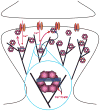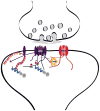CaMKII: claiming center stage in postsynaptic function and organization
- PMID: 24462093
- PMCID: PMC4570830
- DOI: 10.1016/j.neuron.2013.12.024
CaMKII: claiming center stage in postsynaptic function and organization
Abstract
While CaMKII has long been known to be essential for synaptic plasticity and learning, recent work points to new dimensions of CaMKII function in the nervous system, revealing that CaMKII also plays an important role in synaptic organization. Ca(2+)-triggered autophosphorylation of CaMKII not only provides molecular memory by prolonging CaMKII activity during long-term plasticity (LTP) and learning but also represents a mechanism for autoactivation of CaMKII's multifaceted protein-docking functions. New details are also emerging about the distinct roles of CaMKIIα and CaMKIIβ in synaptic homeostasis, further illustrating the multilayered and complex nature of CaMKII's involvement in synaptic regulation. Here, I review novel molecular and functional insight into how CaMKII supports synaptic function.
Copyright © 2014 Elsevier Inc. All rights reserved.
Figures






References
-
- Barria A, Malinow R. NMDA receptor subunit composition controls synaptic plasticity by regulating binding to CaMKII. Neuron. 2005;48:289–301. - PubMed
-
- Bayer KU, De Koninck P, Leonard AS, Hell JW, Schulman H. Interaction with the NMDA receptor locks CaMKII in an active conformation. Nature. 2001;411:801–805. - PubMed
-
- Benke TA, Luthi A, Isaac JT, Collingridge GL. Modulation of AMPA receptor unitary conductance by synaptic activity. Nature. 1998;393:793–797. - PubMed
Publication types
MeSH terms
Substances
Grants and funding
LinkOut - more resources
Full Text Sources
Other Literature Sources
Miscellaneous

